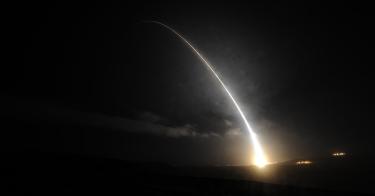The debate over whether to stick with the half-century-old Minuteman III intercontinental ballistic missile or replace it with the Ground Based Strategic Deterrent program just got a whole lot easier. On May 12, Gen. Timothy Ray, commander of U.S. Air Force Global Strike Command, confirmed that extending the Minuteman III through 2075 would actually cost $38 billion more than developing the GBSD.
With this new information, how can anyone still argue for keeping a missile mired in 1960s-era technology over building a new one that’s 28 percent cheaper?
With a price tag of about $95 billion, the GBSD program has long been criticized as too costly. The critics argue that money would be better spent on other priorities, like combating climate change. Meanwhile, they say, the Minuteman III can ensure the nation’s security for a while longer.
But sustaining missiles built before there was even an internet is no cheap task. Adm. Charles Richard, commander of U.S. Strategic Command, recently testified that some parts of the Minuteman III system are so old that contractors no longer know how to make them. And trying to retrofit cyber-secure software into a system built before cyber existed will certainly be expensive.
>>> Nuclear Modernization Is Our Top Defense Priority, and America Can Afford It
The Air Force initially estimated that extending the Minuteman III would cost only $1.1 billion more than GBSD. But that cost difference has now skyrocketed to $38 billion because the earlier estimate assumed that programs to update key missile parts—like the propulsion system, missile guidance set and rocket engines—would get underway in 2015 or 2016. Since the Air Force selected GBSD as the better option for the nation, those decision points have long passed.
Now, switching course and starting those programs this much closer to the Minuteman III’s planned retirement at the end of the decade would cost billions more. That’s what Gen. Ray meant when he said: “We’re out of time” with respect to extending the Minuteman III.
Case closed on the Minuteman III debate? Not so fast.
The $38 billion difference applies to extending Minuteman III through 2075—the same expected length as the GBSD’s lifetime. But many critics propose only extending the Minuteman III for a shorter period of time—through 2040, for instance—while reducing the number of Minuteman III missiles. This option, they say, will be cheaper than GBSD.
There are three major problems with this argument.
First, extending the Minuteman III for a shorter amount of time won’t actually cost much less. The bulk of expenses required to continue using the missile, like starting component upgrade programs, must be paid regardless of the length of the Minuteman extension. In 2016, Gen. Robin Rand, the head of Air Force Global Strike Command at the time, testified that “the cost would not be less if we extend [Minuteman III] until only 2045 because it faces near-term age-out and attrition of assets.”
If the Air Force reduces the Minuteman III fleet enough, then perhaps it can break even with the cost of GBSD. But this would leave the country with a smaller, weaker force when it could have a modern missile in needed numbers through 2075 for the same price.
Second, extending Minuteman III and reducing the fleet would imply unilateral force reductions. Senior officials have repeatedly advised against unilateral reductions because doing so would remove an incentive for our adversaries to negotiate arms control. As Sen. Deb Fischer, R-Neb., aptly questioned: “Why would our competitors agree to new rounds of arms reductions if they knew the U.S. was cutting its forces anyway, regardless of whether they agreed to do the same?”
Third, and most importantly, extending the Minuteman III would make the U.S. missile fleet less credible and less safe. The threat to the U.S. has significantly advanced since the Minuteman III was designed in the 1960s to deter the Soviet Union. For deterrence to be effective, adversaries must believe U.S. capabilities will work as intended and make it to their targets. But as Adm. Richard stated: “Minuteman III is increasingly challenged in its ability to do that.”
>>> China’s Growing Nuclear Threat
For instance, the Minuteman III will lack the advanced cyber defense being built into the GBSD. If adversaries think they can defeat our ICBMs with a cyberattack, doing so may become more attractive.
Sustaining a missile from 50 years ago is also less safe than handling a new missile updated with 21st century safety features. As Gen. Ray explained, every time a Minuteman III missile needs maintenance, the nuclear warhead itself needs to be removed and exposed. With GBSD, the Air Force expects a two-thirds reduction in the number of times a nuclear warhead gets exposed. This will lower both accident risks and sustainment costs.
This leaves the United States with a choice between a 1960s-era missile with increasing vulnerabilities or a brand-new missile with advanced safety features, resilience against threats and $38 billion back in the American taxpayers’ pockets. It is time to put this debate to rest.
This piece originally appeared in Defense News



